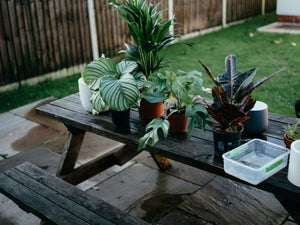Caring for indoor plants is rewarding and enhances your home with beauty and fresher air. A reliable indoor plant care guide can help both beginners and experienced plant owners keep their houseplants healthy. This guide will provide valuable tips on effective indoor plant care and creating an environment where they can flourish.
Why Indoor Plant Care Matters
Proper houseplant care is essential to keep your plants healthy and vibrant. Growing indoor plants enhances your home with greenery, improves air quality, and supports mental well-being. Knowing how to grow houseplants indoors involves understanding their specific needs, including light, water, and nutrients.

Steps for Proper Houseplant Care
Successful indoor house plant care starts with understanding the basics of plant health. Here are some essential key tips for growing healthy plants effectively:
Light Requirements
Light is one of the most critical factors in indoor plant care. Some houseplants thrive in bright, indirect light, while others prefer low-light conditions. When considering how to grow houseplants indoors, it’s important to understand your plant's lighting needs.
Tips:
- Place low-light plants like snake plants in shaded areas.
- Provide bright indirect light for plants like pothos and spider plants.
- Rotate your plants regularly to ensure even growth.
- Position tropical plants near a south-facing window to maximize sunlight.
Watering Needs
One of the most common mistakes in house plant care is overwatering. Taking care of plants means finding the right balance to prevent root rot while ensuring they receive adequate hydration.
Tips:
- Check soil moisture before watering by feeling the top inch of soil.
- Use pots with drainage holes to prevent excess water accumulation.
- Water plants early in the day to allow moisture absorption.
- Reduce watering frequency during the winter months.

Soil and Fertilization
Choosing the right soil and fertilization routine is key when looking after plants indoors. Different plants require different soil compositions to thrive.
Tips:
- Use well-draining soil such as a peat moss-based potting mix.
- Fertilize monthly with a balanced, water-soluble plant food.
- Repot your plants every year to refresh soil nutrients.
- Select plastic pots to help retain moisture for plants needing consistent watering.
Humidity and Temperature
Indoor plant care involves maintaining suitable humidity and temperature levels. Many tropical houseplants prefer higher humidity, while others are more tolerant of drier conditions.
Tips:
- Use a humidifier or mist plants to increase humidity.
- Keep plants away from drafts and heating vents.
- Group plants together to create a microclimate.
- Monitor humidity levels to ensure optimal plant growth.
Pruning and Maintenance
Regular maintenance is an essential aspect of taking care of indoor plants. Pruning encourages growth and keeps plants looking their best.
Tips:
- Remove dead or yellowing leaves promptly.
- Trim leggy growth to encourage bushier plants.
- Clean leaves with a damp cloth to remove dust buildup.
- Inspect regularly for spider mites and other pests.

How to Look After House Plants in Different Conditions
Taking care of indoor plants requires adapting to various home environments. No matter the light conditions in your home, understanding how to care for house plants in different environments is essential.
Low Light Conditions:
- Choose plants like ZZ plants and peace lilies.
- Use artificial grow lights if necessary.
- Place plants near north-facing windows for minimal sunlight.
Bright Light Conditions:
- Consider succulents and cacti.
- Provide occasional shade to prevent leaf scorch.
Common Indoor Plant Problems and Solutions
Even with the best indoor plant care practices, houseplants can encounter issues. Here are some common problems and how to address them:
Yellowing Leaves
- Cause: Overwatering or nutrient deficiency.
- Solution: Adjust watering schedule and fertilize appropriately.
Drooping Leaves:
- Cause: Underwatering or temperature stress.
- Solution: Ensure consistent watering and proper placement.
Brown Leaf Tips:
- Cause: Low humidity or excessive fertilizer.
- Solution: Increase humidity and reduce fertilizer use.

Creating an Indoor Plant Guide for Your Home
If you're wondering how to look after house plants efficiently, consider creating a personalized indoor plant guide. Keeping track of watering schedules, light preferences, and fertilization needs helps in better house plant care.
Steps to create your guide:
- Identify your plant types and their specific needs.
- Monitor growth patterns and adjust care routines accordingly.
- Use reminders to keep up with watering and fertilization schedules.
Houseplant Guide: Best Indoor Plants for Beginners
If you're new to indoor house plant care, starting with low-maintenance plants can help build confidence. Here are a few easy-to-care-for options:
- Spider Plant: Thrives in various light conditions and requires minimal care.
- Pothos: Adapts to different lighting and watering conditions.
- Peace Lily: Beautiful and low-maintenance with air-purifying properties.
- Snake Plant: Known for its ability to withstand drought and adapt to low-light environments.
Q&A: Indoor Plant Care
Q: How often should I water my indoor plants?
A: Watering frequency depends on the plant type and environmental conditions. Most houseplants need watering when the top inch of soil feels dry.
Q: What is the best way to increase humidity for my tropical plants?
A: You can increase humidity by misting the leaves, using a humidifier, or placing a tray of water near the plants.
Q: How can I tell if my plant is getting enough light?
A: If your plant's growth is slow, or the leaves are losing color, it might need more light. Consider placing it near a south-facing window.
Q: What are some common pests that affect houseplants?
A: Common pests include spider mites, aphids, and mealybugs. Inspect your plants regularly and treat infestations with insecticidal soap.
Conclusion
Growing house plants indoors is a rewarding experience that adds life and vibrancy to your home. This indoor house plant guide provides basic knowledge needed to care for plants effectively. A regular care routine supports healthy houseplants, whether for beauty or health purposes. Use this house plant care guide to create the perfect environment for your indoor greenery.
ADDITIONAL RESOURCES
- Best Indoor Plants: A Comprehensive Guide
- Best Indoor Plants for Low Light
- Cat-Safe Houseplants: Pet Friendly Greenery for Your Home
-
Tall Indoor Plants: Transform Your Space With Elegance
- Best Indoor Flowering Plants: Vibrant Blooms For Your Home
- Small Houseplants: Compact Greenery For Every Space
- Easy To Grow Houseplants: Perfect for Beginners
- The Best Plants For Air Purification
- Best Living Room Plants to Elevate Your Space
- Best Large Houseplants to Enhance Your Home
- Best Indoor Plants For Bedroom Spaces
- Best Housewarming Plant Gifts
- Bushy Indoor Houseplants: Add Fullness To Your Space
- Best Indoor Plants For Oxygen
- Brighten Your Space With Colorful Indoor Plants
- Enhance Your Home With Decorative House Plants
- Easy Plants To Keep Alive: Perfect for Any Home
- Evergreen Indoor Plants: Easy Care For Year-Round Greenery
- Best Plants For Floor Planters
- The Best Green Foliage House Plants for A Vibrant Home
- Shop Our Houseplants

